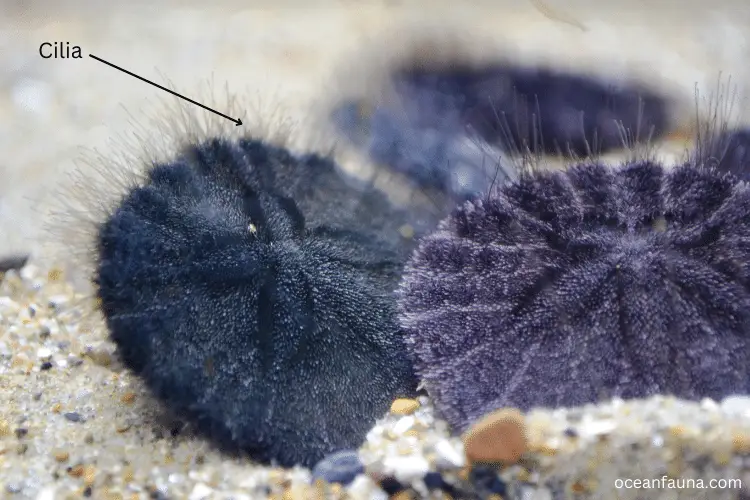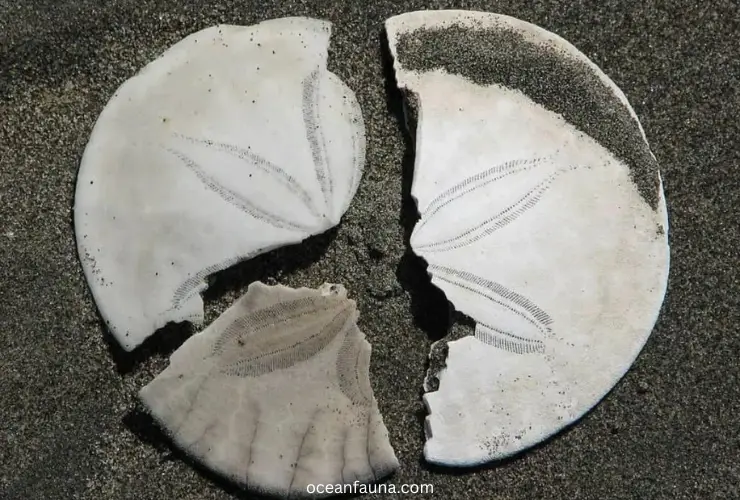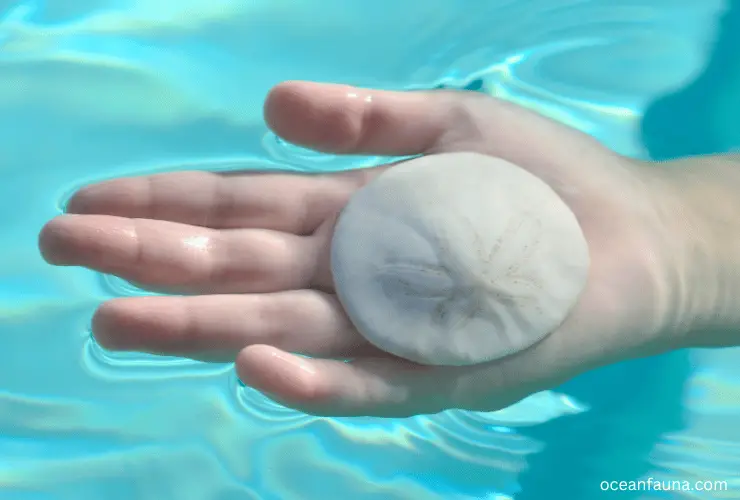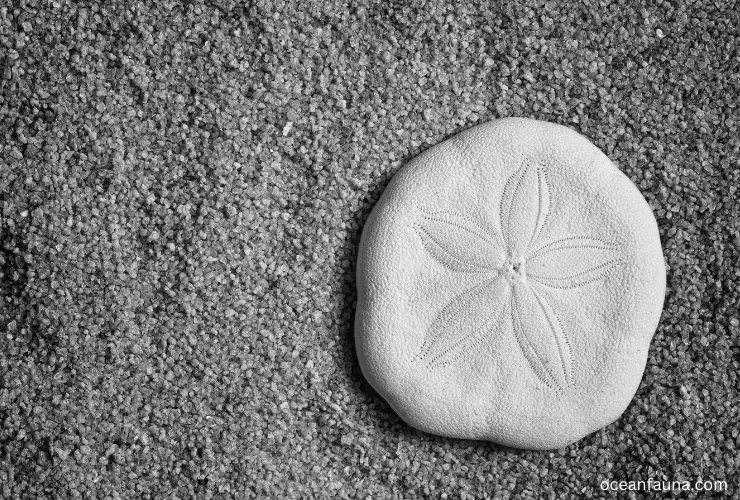Are sand dollars alive? Yes, Sand dollars most definitely are living creatures. There are even signs of whether a sand dollar is alive or dead. If a sand dollar is alive, its cilia will be moving, and it may excrete a yellow substance.
Sand dollars are flat and burrowing echinoderms that are mostly found in ocean regions. They don’t live in deep oceans and can be found on beaches. If you find a sand dollar, you might want to take it home as a souvenir.
Let’s find out more about sand dollars to prevent harming them and avoid potential illegal acts.
What Are Sand Dollars: Giving Dollars $$$ or not?
Is a sand dollar an animal or something related to money? Well, sand dollars are animals, no kidding! The name “sand dollar” actually comes from how they look. They’re flat, round, and sport a five-pointed star shape right on their surface. They resemble old silver American and Spanish dollar coins. For that reason they got “Dollar” in their name.
Sand dollars belong to the class of Echinodermata. It means they have spiny skin. But unlike other echinoderms, sand dollars have a flattened shape. They also don’t have any spines on their body, making them look more like a shell than an animal.
Are Sand Dollars Alive or Dead?
Do sand dollars have life? Is a sand dollar alive? Indeed, sand dollars have life, and they are living creatures. They are not a dead thing. However, many people don’t believe that sand dollars are living. But there are many ways to tell whether a sand dollar is alive or dead.
How do you know if a sand dollar is alive?
“How to tell if a sand dollar is alive?” The most obvious way to tell if a sand dollar is alive is by checking whether the coat of cilia (hair-like structures) on its back is moving or not. If they’re moving, it means that the sand dollar is alive. In that case, you should put it back into the ocean water as soon as possible.

Another way to see whether it’s alive is by placing it on your palm and checking whether it has released a yellow substance. If you see a yellow stain on your palm, that means it is alive.
Lastly, another way to check whether a sand dollar is alive or dead is by its appearance, color, and shape.
Here are some kinds of appearances and what they tell us about the sand dollar.
Brown Sand Dollars Alive or Dead
If a sand dollar is brown, red, or even purple, it means it is alive. If the sand dollar you see is dark and not white, it is most probably alive. If you’re unsure, you can use the other two methods above to confirm.
Broken Sand Dollars Alive or Dead
Like any other sea creature, if a sand dollar is broken in half, there is barely any chance of survival, and it will be dead. If it is not dead already, it will die soon.
Black Sand Dollars Alive or Dead
Like brown, red, and purple sand dollars, black ones are alive too.
Also Read: Do Sand Dollars Have Brains? [No, Here’s Why]
What’s Inside a Sand Dollar? (Anatomical Discussion)
A sand dollar is a type of echinoderm, a group of marine animals that includes starfish and sea urchins. Inside a live sand dollar, there’s something like a sea urchin. This helps it move and dig into the sand. But what most people know is the empty shell left after the sand dollar dies.

Now, about that shell—it’s round and flat with a bunch of grooves on top that come out from the center. These grooves help the sand dollar move and catch tiny food using its tube-like feet. Flip it over and you’ll find the underside is smooth and soft. This smooth part is where the sand dollar’s body sticks to the shell.
Get this, the sand dollar has more than just grooves and a soft underside. It’s got five jaw sections for grinding its food. It also has around 60 muscles to move its spines and feet.
Guess what? A sand dollar’s skeleton is made of 50 different pieces! And all these pieces are stuck together with some kind of tissue. These pieces form a star shape, each point standing for one of its five arms. This skeleton gives the sand dollar’s body its shape and strength. And don’t forget, that tough skeleton also keeps it safe from predators.
How Long Do Sand Dollars Stay Alive?
The average lifespan of a sand dollar is around 10 years. In some regions, they can live up to 5 years. In fact, it may sound impossible to find a dead sand dollar. However, considering there are about 11 different sand dollar species, you can find some dead sand dollars at the beach.
Let me tell you, sand dollars are alive only underwater. Out of the water, they can’t live for long.
Do you know how long do sand dollars live out of water? Well, if a sand dollar is washed onto the shore, it won’t be able to last for more than a few minutes. So, if you find a sand dollar on the beach and see its coat of cilia is not moving, it might be dead.
How Long Can Sand Dollars Live out of Water?
In short, sand dollars can only survive out of water for a few hours. Like most aquatic creatures, they depend on water for their essential functions. They are well-suited for life in the ocean.
They need water for respiration and to transport nutrients to their bodies. When you take sand dollars out of the water, they can’t get oxygen and nutrients they need. This can hurt them and cause their death.
To make sure they survive and stay healthy, it’s important to quickly put them back in the water. That way, you’re not just helping it survive, but also ensuring it remains in tip-top shape.
How Do Sand Dollars Die?
How do sand dollars meet their end? Well, these critters can only survive underwater. If they leave the water, they can’t live for long. So, what could make a sand dollar bite the dust?
Well, one common reason is drying out. They need water to live. Take them out, and they start drying up. After a while, they get stiff and can’t move or eat anymore. This could last a few hours to days, but sadly, it kills them in the end.
Another threat they face is predators. Sharks and other bigger fish feed on them frequently. Apart from fish, crabs and seagulls also prey on them. Seagulls often pick them up and smash them on rocks to eat what’s inside. So, yeah, they can’t defend themselves, which often leads to their death.
Is it Illegal to take Dead Sand Dollars?
When you find such a beautiful and rare creature at the beach, you may want to take it home as a souvenir. But you can’t just take a sea creature home without knowing whether it’s alive or dead. Well, taking a dead sand dollar is NOT illegal. However, if it is alive, then you might need to suffer some consequences.

In many states, taking a live sand dollar home is illegal. Most states have very strict laws regarding collecting sand dollars. For example, if you take live sea dollars, including other sea creatures from South Carolina beaches, you can be charged with a fine of $500.
In some other states, if a sand dollar is dead, you are free to take it home. Otherwise, you can only take live sand dollars home in states like Florida if you have a recreational saltwater fishing license.
Also Read: Do Sand Dollars Have Eyes? [Scientific Facts]
What Happens to a Sand Dollar When It Dies?
Living sand dollars are covered in small bristles that help them move across the sand. Underneath the small bones is a symmetrical design on the back of a sand dollar that is covered by bristles.
When a sand dollar dies, one of the first things that happen is that the bristles or cilia on its back fall off, exposing the design on its skeleton or the ‘test.’ Then, when the skeleton is exposed, it is eventually bleached by the sun, and the sand dollar loses its dark color and eventually turns white.
The color change is also one of the signs that can be observed to tell whether it is dead or not.
How Much is a Sand Dollar Worth? (Live vs Dead Sand Dollar)
Sand dollars are not rare, so they cost less than other rare sea creatures or shells. So, how much is a living sand dollar worth? Normally, the cost of a live sand dollar for keeping in aquariums is about five to fifteen dollars.
What about the dead one? How much is a dead sand dollar worth? Well, the cost of a dead sand dollar is not that different from a living one. Dead sand dollars are also worth about five dollars in local decorative markets.
FAQs
Why are Some Sand Dollars Black?
If a sand dollar is white, it is probably not alive. That is because black sand dollars, or a little dark in color, do not have their ‘tests’ or skeletons showing through. This means that if a sand dollar is black, it is alive.
Why Do Sand Dollars Turn Black?
Sand dollars come in various colors, such as black, brown, red, purple, and sometimes green. These sea urchins do not turn black because they are mostly already black. When A sand dollar dies, it will turn white from black, never the other way around.
Are sand dollars rare?
No, sand dollars are not rare. In fact, they can be found on most beaches around the world. They are most commonly found in the shallow waters of the Pacific and Atlantic oceans. However, they can also be found on beaches in other regions, such as the Caribbean and Mediterranean.
Are sand dollars dangerous?
No, sand dollars are not dangerous. While they have spines on their body, they are not harmful to humans and cannot be used for defense. However, handle sand dollars gently as they can easily break and die when removed from the water.
What do sand dollars eat?
Sand dollars mainly feed on microscopic organisms like plankton, algae, and bacteria. They do this by using their spines to sweep food particles into their mouths located on their underside. This process also helps to aerate the sand around them, keeping it clean and healthy for other marine animals.
Are Gray Sand Dollars Alive?
No, gray sand dollars are most likely dead. Sand dollars that look gray or a little tan are dead because they don’t have the tiny coat of cilia or “furry spines” on their back.
What does a live sand dollar look like?
A live sand dollar will have a dark or black underside with small, moving spines covering it. These spines help the animal move and feed. The top of a live sand dollar may also be covered in a thin layer of fur-like material that helps it camouflage on the ocean floor. And get this, the color can be really striking, ranging from a rich reddish-brown to even a vibrant shade of purple.
Do sharks eat sand dollars?
Yes, sharks do eat sand dollars, but they are not their primary food source. Sharks are known to feed on a variety of sea creatures, including small fish, crustaceans, and even other sharks. Sand dollars make up only a small part of sharks’ diet.
Are Sand Dollars Soft When Alive?
Usually, sand dollars found on the beach, which are mostly dead, are smooth and hard and can be bleached by the sun. However, if a sand dollar is soft, it is alive. This is because the coating of cilia on top of a sand dollar is a little soft and is moving.
Conclusion
Hopefully, this article will help to differentiate a live vs dead sand dollar. Sand dollars are sea urchins that beachgoers like to collect as souvenirs. Before picking up a sand dollar to take home, you must ensure it’s dead because collecting alive sand dollars can be illegal in your region.


3 thoughts on “Sand Dollars: Alive or Dead?-Everything You Need to Know”